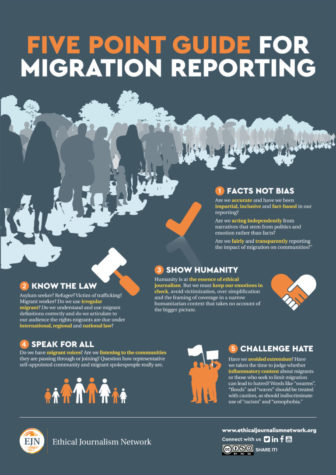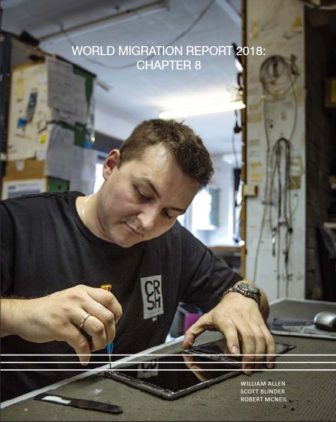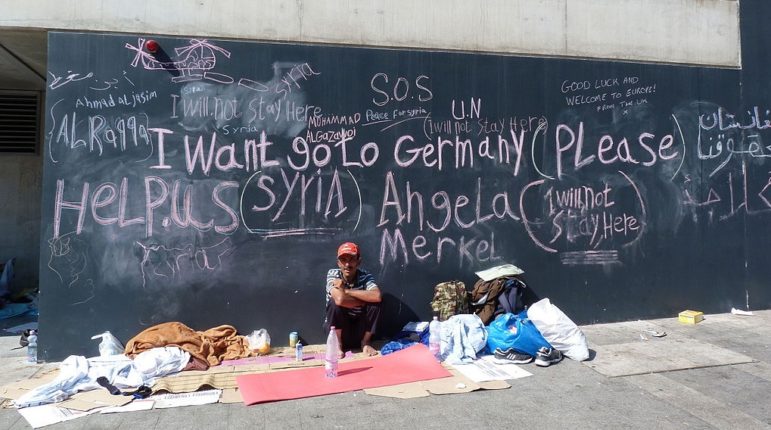Migration Reporting: Guidelines and Assessment
Journalism about migration has come under close scrutiny and not infrequent criticism, largely for shallowness, prejudice and exaggeration.
The Ethical Journalism Network (EJN), a London-based NGO that follows media coverage of migration, has created migration reporting guidelines.
 The five-point guidelines urge:
The five-point guidelines urge:
- Facts not bias
- Know the law
- Show humanity
- Speak for all
- Challenge hate
Journalism about migration, unfortunately, often falls short of these goals, according to several recent studies.
“Censorship, particularly self-censorship,” begins a list of infirmities written by Aidan White, a journalist who founded EJN, and Ann Singleton, senior research fellow at the University of Bristol and senior advisor to International Organization of Migration’s Global Migration and Data Analysis Centre (IOM).
Their list continues with: lack of resources, lack of skills and knowledge, inexact use of terminology, undue political pressure, the rise of hate speech, a limited range of sources and a lack of international focus.
“In addition, there is little focus on migration success stories, the importance of remittances, the positive aspects of labor migration and the cultural richness of diaspora communities and their contribution to human development,” they write in Chapter Three of Fatal Journeys, published by IOM. The report also includes a variety of suggestions to improve coverage, such as:
Above all, media need to recognize that migrants and refugees are often vulnerable minorities who can quickly become scapegoats for the ills of society — social and economic decline, crime and unemployment, pressure on health and welfare services and lack of security.
EJN also published Moving Stories, an international review, with chapters on how the media covers migration in 15 countries and regions.
A 2019 e-media Toolkit about covering migration “provides first-hand assistance to media professionals with learning resources, training courses, and opportunities to share and interact.” It was developed by the European Union Agency for Fundamental Rights, the European Broadcasting Union and the Ethical Journalism Network with the support of the European Federation of Journalists.
“Journalists are often poorly informed about the complex nature of migration as a phenomenon,” concludes an EU-funded study of 17 countries in the Euro-Mediterranean, carried out by EJN for the International Centre for Migration Policy Development. The study also highlights “inspirational examples of journalism at its best — resourceful, painstaking and marked by careful, sensitive and humanitarian reporting.” It calls for training, better funding of media action and other activities to support and foster more balanced and fact-based journalism on immigration, emigration, integration, asylum and other migration-related challenges. Useful in the report is a “Desktop Study” chapter that includes codes of ethics, glossaries and guidelines on reporting.
How the media contributed to the migrant crisis, is a provocative 2019 article in The Guardian by Daniel Trilling calling for deeper context in reporting. The article was adapted from a chapter in a book, Lost in Media, published by the European Cultural Foundation.
IOM Report Sees More Positive Coverage
 Media coverage worldwide is addressed in Chapter Eight in the latest edition of the World Migration Report from the IOM, where, among other observations, the report’s authors say there has been movement towards more positive — or at least more neutral — coverage of migration issues. They also point to social media offering new avenues for “migrant-led” journalism.
Media coverage worldwide is addressed in Chapter Eight in the latest edition of the World Migration Report from the IOM, where, among other observations, the report’s authors say there has been movement towards more positive — or at least more neutral — coverage of migration issues. They also point to social media offering new avenues for “migrant-led” journalism.
IOM makes a case for media coverage of migrants that is reasonable, measured and not based on suspicion. The report also notes there are legitimate reasons for media to discuss different types of migration and their costs and benefits.
A frequent topic in commentary on migration journalism is how to balance human interest reporting, which serves to humanize refugees, and broader analytic reporting, which looks at the causes and consequences of migration.
“Scholars of migration journalism have argued that migration is hard to cover because it’s a story that oozes, rather than breaks — so the breaking news of a smuggling ship sinking is easier to do than the massive sociopolitical, demographic and economic challenges of the entire phenomenon,” wrote Giovanna Dell’Orto, a journalism professor at the University of Minnesota, in a January 2017 post on the blog of the Media Governance & Industries Lab at the University of Vienna.
Some journalists act more like “disaster tourists than migration correspondents,” Anna Masera, public editor of Italian daily La Stampa, was quoted as saying in a 2016 article in journalism.co.uk.
They are creating “moving storytelling without really explaining politics, giving the data or giving context to the data,” she said, adding that simply publishing high resolution photography of the crisis is not enough.
The value of using data also is discussed in “Why Data Journalism is Crucial to the Migration Debate,” a 2016 story by Ingrid Cobben of the World Association of Newspapers and News Publishers.
“Behind the scenes of migration media reporting,” by Barbara Kuznik in the Reminder blog, discusses research on media practices in nine EU member states based on 221 interviews that resulted in two reports.
“This work explores not only how journalists perceive the national narratives around migration that they themselves help to generate, but also what is hidden behind the scenes — the presumptions, processes, norms and pressures that they face on a daily basis in their work.” The Reminder project brings together a consortium of 14 organizations, combining expertise from different fields including: development, economics, linguistics, media studies, political science and public policy.
How Can We Tell Migrants’ Stories Better? Here Are 10 Ways by Belén Arce Terceros based on interviews with journalists covering the story. (In Spanish)
The Emotional Toll
The results of a study released in 2018 addresses the emotional effects of covering the refugee crisis.
Commissioned by the International News Safety Institute, the study was conducted by Anthony Feinstein, a professor of psychiatry at the University of Toronto, who has previously researched how journalists are affected psychologically by their work in zones of war, conflict and disaster. He looked at “moral injury,” defined as “the injury done to a person’s conscience or moral compass by perpetrating, witnessing, or failing to prevent acts that transgress personal moral and ethical values or codes of conduct.”
The conclusion states:
Moral injury rather than PTSD [post-traumatic stress disorder] or depression emerged as the biggest psychological challenge confronted by journalists covering the migration crisis. Given that moral injury is strongly associated with journalists becoming actively involved in helping refugees, the industry needs to reach consensus on defining appropriate expectations in situations such as these.
Good journalists will of course feel moved by the migration crisis, but they cannot fix it and should not attempt to do so. Guilt, which is often misplaced, can be a faulty motivator of behaviour. So too can moral injury. Here journalists need to understand where their emotions are coming from and that it is okay to feel distress in the context of what they are witnessing. However, when the lines are blurred and journalists start regularly assisting migrants, emotions can unravel.
Feinstein suggests proactive education, so that journalists “have a very clear understanding of what their role is when they go and cover a story.”
Resources Designed for Journalists
There are a few resources on migration specifically designed for journalists.
The International Labour Organization has posted Guidance for Journalists. The preamble comments:
Wittingly or unwittingly, media can play its part in creating an unbalanced discourse about migration, including labor migration. Inaccurate, biased media reporting can lead to misinformation, and at worse, may be an instigator for discrimination and unfair treatment.
5 tips for reporting on migration in Africa — and around the world, written by Patrick Egwa and published in 2020 by the International Journalism Network.
Open Migration is a site by CILD, the Italian Freedom and Civil Rights Coalition, that aggregates news stories and has a reference section.
In Germany, Media Dienst Integration keeps up with migration-related news with a media audience in mind, and offers help finding expert sources. The website is a project of the “Council for Migration eV” (RfM), a nationwide association of migration researchers.
Also in Germany, a project announced in February 2018 called Newscomer, will partner a refugee or foreign journalist with a local journalist in Germany, enabling them to collaborate on stories.
Ethics and Interviewing
More generally, the need for sensitive interviewing of immigrants frequently arises.
Resources developed in the context of reporting on human trafficking are relevant and are summarized on the GIJN Resource Page on human trafficking an slavery.
Reporting on Refugees, Asylum Seekers and Immigrants was created by 90 Days 90 Voices, to provide “guidelines to ethical immigration reporting.” The US group “tells the stories of those seeking a home in the United States during an age of unrest through personal narratives, audio, photography, comics, and live journalism events.” The guide says in part:
Above all, we call on ourselves and other journalists to avoid “the second wound” — the hurtful impact that thoughtless, inaccurate and careless reporting can have on vulnerable immigrants often fleeing war, instability and tragedy.
Advice for interviewing refugees was offered in journalism.co.uk.
A toolkit on “how journalists can do a better job of talking about refugees” was issued in 2018 by The Discourse, a Canadian community of journalists and others.
Also see GIJN’s Resource Page on Interviewing.









